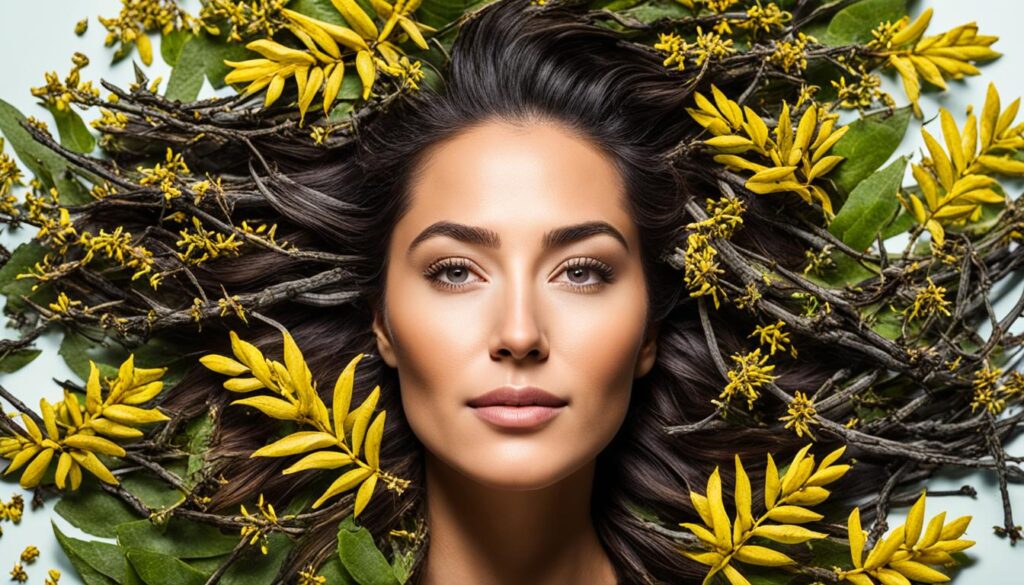As a professional copywriting journalist, I want to share with you the amazing benefits of using witch hazel for hair care. Witch hazel is a versatile ingredient that offers numerous benefits for your scalp and hair. Whether you’re dealing with oily hair, scalp inflammation, or looking for a natural remedy for dandruff, witch hazel can be a game-changer in your hair care routine.
One of the most notable benefits of witch hazel is its oil-reducing capabilities. If you have oily or greasy hair, witch hazel can help balance and control the excess oil production on your scalp, leaving your hair looking fresh and clean. Additionally, witch hazel acts as a natural soothing agent, providing relief for dryness, itching, and irritation on the scalp.
While more research is needed to confirm its effectiveness as a hair growth treatment, some anecdotal evidence suggests that witch hazel may help prevent hair loss by soothing the hair follicles. Its anti-inflammatory properties can support a healthier scalp environment for optimal hair growth.
When it comes to using witch hazel for your hair care routine, there are a few tips to keep in mind. First, choose an alcohol-free witch hazel product to avoid drying out your scalp. You can apply it directly to your scalp using a dropper, spray bottle, or saturated cotton pad. For a sensitive scalp, dilute witch hazel with water and gently pat it into your hairline and part. Allow it to sit for a few minutes before rinsing or leave it in without shampooing for additional benefits. You can also explore hair care products that contain witch hazel, such as shampoos, conditioners, or scalp treatments.
For those who prefer DIY solutions, there are several recipes you can try incorporating witch hazel. From a scalp spray to enhancing your regular shampoo, these homemade options allow you to customize your hair care routine with the benefits of witch hazel.
Key Takeaways:
- Witch hazel is a versatile ingredient with numerous benefits for hair care.
- It helps reduce oiliness, soothes inflammation, and provides relief from scalp irritation.
- While its effectiveness for hair growth is still being researched, witch hazel may potentially prevent hair loss.
- Choose alcohol-free witch hazel products for scalp-friendly application.
- You can apply witch hazel directly or opt for hair care products containing this beneficial ingredient.
The Benefits of Witch Hazel for the Scalp
Witch hazel offers several benefits for the scalp. Its astringent properties help reduce oiliness by controlling sebum production and absorbing excess oil from the scalp. This makes it particularly useful for individuals with oily or acne-prone scalps. Witch hazel also helps reduce flaking and dandruff by acting as a natural cleanser and anti-inflammatory. It soothes scalp irritation, reduces redness, and provides relief from itching and flaking. Additionally, witch hazel has been found effective in calming inflammation on the scalp, making it a beneficial ingredient for those with conditions like psoriasis or eczema. Its anti-inflammatory properties help alleviate symptoms and promote scalp health.

| Benefits of Witch Hazel for the Scalp | Description |
|---|---|
| Reducing Oiliness | Controls sebum production and absorbs excess oil from the scalp. |
| Reducing Flaking and Dandruff | Acts as a natural cleanser, soothes scalp irritation, and reduces redness, itching, and flaking. |
| Calming Inflammation | Effective in calming inflammation on the scalp, providing relief for conditions like psoriasis or eczema. |
How to Use Witch Hazel for Hair Care
Incorporating witch hazel into your hair care routine is simple and effective. Follow these tips to make the most of the benefits of witch hazel for your hair:
- Choose alcohol-free witch hazel: Opt for an alcohol-free witch hazel product to prevent drying out your scalp.
- Direct application: You can apply witch hazel to your hairline and part using a dropper, spray bottle, or saturated cotton pad.
- Leave-in treatment: Leave the witch hazel on your hairline and part for 5 to 10 minutes before shampooing as usual.
- Dilute for sensitive scalp: If you have a sensitive scalp, dilute the witch hazel with water and gently pat it into your hairline and part. Leave it in without shampooing for 1 to 2 times a week.
- Hair care products: Consider using hair care products that include witch hazel as an ingredient. Look for shampoos, conditioners, or scalp treatments that offer the benefits of witch hazel along with other nourishing ingredients.
By following these tips, you can effectively incorporate witch hazel into your hair care routine and enjoy its many benefits.

Frequently Asked Questions:
Can I leave witch hazel in my hair overnight?
It is not recommended to leave witch hazel in your hair overnight. It is best to follow the recommended application time and then shampoo as usual.
How often should I use witch hazel for my hair?
The frequency of use depends on your hair type and scalp condition. For most individuals, using witch hazel once or twice a week is sufficient. However, if your scalp is oily or prone to dandruff, you may benefit from more frequent use.
| Pros | Cons |
|---|---|
| Reduces oiliness | May cause dryness if not used carefully |
| Provides relief from scalp irritation | Not suitable for everyone, may cause allergies |
| Helps control dandruff and flaking | Limited research on its hair growth properties |
| Calms inflammation on the scalp |
Witch Hazel DIY Hair Recipes
If you prefer homemade hair care solutions, there are several DIY recipes you can try using witch hazel. Incorporating witch hazel into your hair care routine can provide various benefits for your hair and scalp. Here are some simple and effective recipes:
1. Scalp Spray
For a refreshing scalp spray, combine alcohol-free witch hazel with hempseed oil and scalp-safe essential oils like lavender or peppermint. Mix these ingredients in a spray bottle with distilled water and shake gently to incorporate. Apply the scalp spray directly to your scalp, focusing on areas that tend to get greasy or itchy. This spray can help control excess oil, soothe irritation, and promote a healthy scalp.
2. Enhance Shampoo
If you want to enhance the cleansing and oil-controlling properties of your regular shampoo, simply add a few drops of alcohol-free witch hazel into it. Mix well before using it as usual. This addition can help remove build-up, excess oil, and impurities from your hair and scalp, leaving them refreshed and revitalized.
3. DIY Witch Hazel Shampoo
Create your own nourishing and cleansing shampoo by mixing the following ingredients:
| Ingredients | Measurements |
|---|---|
| Coconut milk | 1/4 cup |
| Jojoba oil | 1 tablespoon |
| Aloe vera gel | 1 tablespoon |
| Liquid Castile soap | 2 tablespoons |
| Witch hazel facial toner | 1 tablespoon |
| Scalp-safe essential oils (e.g., lavender or rosemary) | A few drops |
Mix all the ingredients thoroughly in a bottle. Wet your hair, apply the shampoo mixture, and gently massage it into your scalp and hair. Rinse well and follow with a conditioner if desired. This homemade shampoo combines the benefits of witch hazel with other nourishing ingredients to promote healthy hair and scalp.
Experiment with these DIY recipes and find what works best for your hair and scalp. Remember to choose alcohol-free witch hazel products to avoid drying out your scalp. Enjoy the natural benefits of witch hazel as you pamper your hair with homemade creations!
Conclusion
Witch hazel is a versatile and beneficial ingredient for hair care. It offers multiple advantages for the scalp, including reducing oiliness, flakiness, and inflammation. While there is limited research on its hair growth properties, anecdotal evidence suggests its potential in preventing hair loss and promoting healthier hair growth.
When using witch hazel, it is important to choose alcohol-free products to avoid drying out your scalp. You can apply it directly to your scalp or opt for hair care products that contain witch hazel. Additionally, DIY recipes provide the flexibility to customize your hair care routine according to your specific needs and preferences.
Overall, witch hazel is a natural and effective option for those seeking healthier and more balanced hair and scalp. Incorporating witch hazel into your hair care routine can help you achieve beautiful and nourished hair while maintaining a healthy scalp. Give witch hazel a try and experience its benefits for yourself!
FAQ
What are the benefits of using witch hazel for hair?
Witch hazel offers several benefits for hair care, including reducing oiliness, soothing the scalp, and calming inflammation. It can also help to reduce flakiness and dandruff by acting as a natural cleanser and anti-inflammatory.
How do I use witch hazel for hair care?
There are several ways to incorporate witch hazel into your hair care routine. You can apply it directly to your scalp using a dropper, spray bottle, or saturated cotton pad. Another option is to use hair care products that contain witch hazel, such as shampoos, conditioners, or scalp treatments. You can also create DIY hair care solutions using witch hazel, such as scalp sprays or homemade shampoos.
Can witch hazel help with hair growth?
While there is limited research on its hair growth properties, some anecdotal evidence suggests that witch hazel may help prevent hair loss by soothing the hair follicles. However, more research is needed to confirm its effectiveness as a hair growth treatment.
Is it necessary to choose alcohol-free witch hazel products?
Yes, it is recommended to choose alcohol-free witch hazel products to avoid drying out your scalp. Alcohol can be harsh and may strip the hair and scalp of natural oils.
Are there any DIY hair care recipes using witch hazel?
Yes, you can create DIY hair care recipes using witch hazel. For example, you can make a scalp spray by combining alcohol-free witch hazel with hempseed oil and scalp-safe essential oils. You can also add a few drops of alcohol-free witch hazel into your regular shampoo to enhance its cleansing and oil-controlling properties. Additionally, you can make a DIY witch hazel shampoo by mixing coconut milk, jojoba oil, aloe vera gel, liquid Castile soap, witch hazel facial toner, and scalp-safe essential oils.






